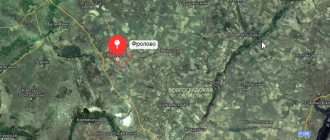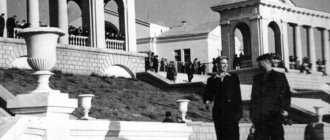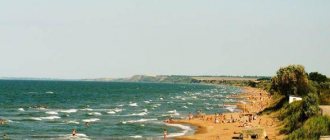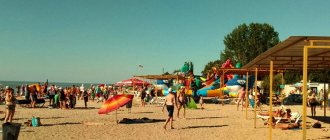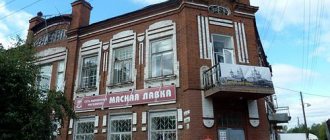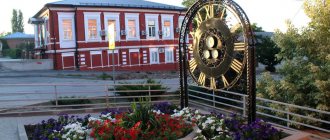Azov
(former names Azak (XIII-XIV centuries), Tana (XV-XVI centuries) - a city in the Rostov region, the administrative center of the Azov region. Population - 81,995 people (2015).
The first fortified settlements were formed on the Azov land more than two thousand years ago.
Seven wonders of the Don
Total votes: 13 750 |
| Voting Information |
Azov today is a compact, cozy, very green city, with an industrial zone located outside the residential areas. In the old part of the city, the fortifications of the Azov fortress of the 18th century have been preserved - the ramparts, the ditch, and the Alekseevsky Gate.
Azov is one of the historical cities with a protected cultural layer.
From time immemorial, the city occupied an important strategic position, which had a great influence on its history. The city is the oldest in the Rostov region; its history began more than two thousand years ago, when the first Scythian settlements arose. From history we also know about such peoples as Cimmerians, Scythians, Sauromatians and Maeotians inhabiting the territory of the city. During the Scythian era, many settlements arose in the Northern Azov region, which later played an important role in the development and formation of the region: these are the Taganrog settlement, the Elizavetovskoye settlement, the Great Greek colony, the Bosporan colony of Tanais and several others.
In 1559, Azov was besieged by Dmitry Vishnevetsky. In 1637, the Don and Zaporozhye Cossacks took Azov and held it until 1642 (the so-called Azov siege). Cossacks took part in the Azov campaigns of 1695-1696, as a result of which Azov passed to Russia. Since 1709, Azov became a provincial city. During the Prut campaign of 1711, the Russian army, being surrounded, was forced to surrender. The Treaty of Prut was concluded, according to which Russia ceded Azov to the Ottoman Empire.
During the Russian-Turkish War of 1735-1739, the fortress was taken by the troops of General Lassi in 1736. According to the Peace of Belgrade in 1739, the fortress was returned to the Ottoman Empire, but under the terms of the treaty with Russia, all fortifications were razed. In March 1769, with the beginning of a new Russian-Turkish war, the city was again occupied by soldiers of the Vologda regiment and Don Cossacks; Since then, the city has forever remained with Russia.
In 1775, Azov was made the administrative center of the newly established Azov province. In 1782, upon the transfer of the provincial administration to Ekaterinoslavl, Azov was renamed again into a fortress, on March 31, 1810 - into a posad of the Rostov district of the Ekaterinoslav province, and in 1888 it was annexed to the Don Army Region and transferred under Cossack control.
At the end of the 19th century, there was a 4-grade men's gymnasium in the settlement, as well as women's and men's schools; trade dropped significantly.
In 1926, Azov again received the status of a city.
During the Great Patriotic War of 1941–1945, Azov was occupied by Nazi troops on July 27, 1942. It was liberated on February 7, 1943 by troops of the Southern Front during the Rostov operation.
Modern Azov is a city of regional subordination, located in the southwestern part of the Rostov region, on the left bank of the Don River, 12.5 km in a straight line from its confluence with the Taganrog Bay. From the regional center - the city of Rostov-on-Don - 35 km. The area of the city is 66.2 km².
There are many bright pages in the history of the city. One of them is the famous Azov siege, when in 1641 a fortified Cossack fortress with five thousand Cossacks withstood the onslaught of a 250,000-strong Turkish army for 93 days and nights.
Background
Sixteen kilometers from the mouth of the Don, on the left bank of the river, a high hill rises. A convenient place to close access to the Sea of Azov. Back in the 6th century. BC e. The Greeks founded the city of Tanais here in the 10th-11th centuries. this city was part of the Tmutarakan principality of Kievan Rus, then it was captured by the Polovtsians, then it became one of the cities of the Golden Horde. In the XIII-XV centuries. the rich Italian colony of Tana was located here.
Turkish expansion
In 1471, the city was captured by the Turks and turned into a powerful fortress that controlled the steppe expanses of the Lower Don and the North Caucasus. A high stone wall with 11 towers surrounded the hill. The suburbs were covered with ditches and earthen ramparts. The fortress was defended by a four thousand-strong infantry garrison with over 200 cannons.
Crimean raids
The Crimean khans, being vassals of the Turkish sultans, considered themselves at the same time the heirs of the Golden Horde and laid claim to receiving permanent tribute from the Russians. Tatar attacks bled the Russian state dry. During the first half of the 17th century. The Tatars captured about 200 thousand Russian people for sale in slave markets. In Azov, captives were sold into slavery to eastern merchants.
In the spring of 1637, Sultan Murad IV decided, with the help of the Crimean cavalry, to strike Iran, with which Turkey was at war. The Sultan's court hoped that after the conclusion of a peace treaty with the Polish-Lithuanian Commonwealth in 1634, nothing would threaten the Turkish possessions from the north, and the Russian state, weakened by the Smolensk War, would also not take offensive actions. Therefore, the Sultan's army was thrown against the Shah and the troops of vassals were brought in.
Cossack attacks on Azov
The Cossacks themselves often attacked Azov and its suburbs, devastated them and, if successful, took tribute from the Azov people in money, salt, and fishing gear. Turkish troops from Azov, in turn, ravaged Cossack towns. In 1574, the Cossacks captured the outskirts of Azov, taking many prisoners, including the Sultan's brother-in-law. In 1625 they managed to break into the fortress, from which they were driven out with difficulty. A special tower (kalancha) at the mouth of the Don, which covered the exit to the sea with cannon fire, was destroyed by the Don. In 1634, the Azov fortress was subjected to a joint attack by the Don and Zaporozhye Cossacks. The Cossacks took the corner tower by storm, but the tower walls collapsed and stones covered the entrance to the city. When the Turkish army concentrated all its forces in Iran, and the Crimean and Nogai cavalry were drawn into the war with the Moldavian prince Cantemir, the population of the Azov and Black Sea regions and in Istanbul expected a repetition of lightning-fast Cossack raids.
Capture of the fortress by the Cossacks in 1637
The decision of the military circle
The decision to march to Azov was made by the military circle in January 1637. Perhaps a letter was sent to the Cossacks asking for help. By spring, warriors began to gather in the lower Don towns. In total, about 4.5 thousand people gathered. In the Monastic town, a large Cossack circle determined the day of the speech and the plan for the siege of Azov. The circle elected Mikhail Tatarinov as marching ataman.
Capture of the fortress by the Cossacks
The siege of the fortress began on April 21, 1637. Previously, the Don people erected fortifications around Azov: they dug ditches, built embankments almost close to the Azov stone walls, so that they could throw stones at those besieged. Long days of siege dragged on with skirmishes, attempts by the Donets to destroy the walls with cannon fire, and repelling the attacks of the besieged.
On May 22, the “sovereign’s salary” (gunpowder, 50 cannonballs for 84 cannonballs, cloth, 2 thousand rubles) arrived from Voronezh with a caravan of ships of 49 plows.
The siege continued. The cannon fire managed to damage the fortifications, but still the destruction was not so great that an assault could be launched. They made a tunnel and dug for about a month. Early in the morning of June 18, a powerful explosion created a hole in the wall 10 fathoms (more than 20 meters). Through this passage the Don people broke into the fortress. A bloody hand-to-hand battle broke out on the streets of Azov, lasting three days. It was especially difficult to storm the four towers, where 30-50 people were holed up in each. Azov soldiers fought in one of the towers for two weeks.
During the capture of Azov, the Don people gave freedom to two thousand Orthodox Christians. To their 94 cannons, the Cossacks added 200 large, medium and small cannons captured in Azov.
Azov under Cossack rule
The tsarist government assured the Sultan of its non-involvement in the Cossack campaign.
By the summer of 1638, the Cossacks had restored the previous fortifications. Cannons were placed on the towers and walls. We accumulated a year's supply of food. To protect Azov from the steppes, a mounted guard of about 400 people was created. These horsemen constantly went on trips of 10 - 20 miles.
The losses suffered by the Cossacks were replenished thanks to the arrival of Russian people, as well as Zaporozhye Cossacks. Azov quickly turned into a large trading city, to which Russian, Turkish and Iranian merchants came with goods. Fearing infiltrators disguised as traders, the Cossacks banned trade inside the Azov fortress.
Industry, communications
There are several large industrial enterprises in the Azov region. The largest of them, OJSC Azov Baby Food Plant (AKDP), specializes in the production of canned baby food. In terms of baby food production volumes, the plant is the largest in Europe. It is planned to put into operation several new production facilities. Among them: the Anakom noodle production plant in the village of Samarskoye, brick factories in Samarskoye and Kagalnik, a terminal for transshipment of valuable cargo, and a computer assembly plant in the village of Ovoshchnoye.
In recent years, more than 10 automatic telephone exchanges have been built and reconstructed, which made it possible to increase the number of subscribers from 4339 to 6206. One of the first rural digital automatic telephone exchanges in the Don was put into operation in the village of Peshkovo.
Beginning of "sitting"
There is a gap in archival sources related to the events of 1641, so the events were often reconstructed by historians on the basis of literary sources (like “The Tale of the Seat of Azov”), which decorated the narrative with patriotic pathos and attributed fictitious speeches to the heroes. The reliability of the information contained in these sources is a matter of debate. There is, however, some third-party evidence that makes it possible to reconstruct in general terms the course of the collision.
Turkish forces
In January 1641, the army of the Crimean Khan suddenly appeared under the walls of Azov. Sultan Ibrahim gathered significant forces for the siege of Azov. The fleet concentrated in Anapa consisted of 100 penal ships, 80 large and 90 small ships. There were about a hundred wall cannons that fired cannonballs weighing up to a pound. In addition to the Janissaries, the fortress was besieged by soldiers recruited from Arabs, Greeks, Serbs, Albanians, Hungarians, Wallachians and other nationalities inhabiting lands subject to the Ottoman Empire. In the Turkish army there were also “city-dwellers, attack and underground wise inventors, glorious inventors of many states” from Spain, Venice, France and Sweden. They were experts in the destruction of fortifications. The total number of Turkish-Tatar forces was estimated by contemporaries differently - more than 120 thousand (of which 50 thousand Tatars, 10 thousand Circassians, 20 thousand Janissaries, 20 thousand Sipahis and a “larger number” of Moldovans and Vlachs), 150 thousand ... and even 240 thousand (of which 40-50 thousand foot soldiers and 40 thousand Tatar and Nogai cavalry); More than 40 galleys were needed to transport them; some of the soldiers traveled to the site of the siege by land.
Cossack forces
At the beginning of 1641, about a thousand Cossacks lived in Azov. 1200 heads of bulls, cows and horses were brought to the fortress for food. By the day the enemy appeared in Azov, over 5 thousand Cossacks and 800 women had gathered. Women, along with men, took an active part in the defense of the fortress. Thus, the strength of the Turkish army alone (without the Crimeans) exceeded the Azov garrison by 6 - 8 times, and in general by 40 - 50 times. The Cossacks elected Osip Petrov and Naum Vasilyev as atamans.
Siege
On June 7, 1641, Turkish-Tatar troops under the command of an experienced commander, the Silistrian governor Huseyn Pasha, besieged Azov from all sides. Large Turkish ships remained at sea, and small ones entered the Don and stood opposite Azov. Near the city, the besiegers dug trenches and placed in them cannons and their soldiers ready to attack. The troops hidden in the trenches were inaccessible to the Cossack artillery. Turkish commanders placed siege cannons against the towers, attaching them with chains. This precaution was necessary, because the Cossacks sometimes took the guns with them during forays. The Turks tempted ransom for surrender. The Cossacks’ response to the words of the Turks that they would not receive revenue and help from the Moscow Tsar is curious:
We know what dear people we are in the Moscow state in Rus', we are not needed there for anything... But the Moscow state is populous, large and spacious... But in Rus' we are not even considered a stinking dog. We are running away from that state of Moscow from eternal work, involuntary servitude, from the boyars and from the sovereign's nobles... Who is there to bother about us?.. And we took the city of Azov by our own will, and not by the sovereign's command.
By the beginning of the siege, the fortifications included three stone cities: the fortress of Azov and its suburbs, the “cities” of Toprakov and Tashkalov. The length of the stone walls around them was about 1100 meters. The width of the wall reached 6 meters. The walls were surrounded by a ditch, lined with stone for strength, 8 meters wide and 4 meters deep. From the Azov fortress, the Cossacks secretly dug a series of underground passages, which allowed them to make unexpected forays for the enemy. The Donets also prepared tunnels for explosions and pit traps in advance. Ottoman troops attacked twice, but were repulsed with heavy losses. Already at an early stage of the siege, the Cossacks began to dig trenches under the positions of the Ottoman troops; the blowing up of several such trenches cost the lives of 1 to 2 thousand Janissaries.
After this, Turkish troops laid siege to the fortress according to all the rules of military art. Since the end of June, the fortress was subjected to continuous artillery fire from heavy cannons, causing serious damage to it. The walls were broken down to the ground in many places. Of the 11 towers, only 3 survived, and even those were heavily damaged by the shelling. Then the Cossacks blew up powder magazines in the most threatened part of the fortress. Fleeing from cannonballs, the Cossacks left their houses and dug deep dugouts for housing. After such a strong artillery bombardment, the Turks launched a powerful attack on the fortress. It was difficult for the Cossacks to repel the blow of the numerically superior troops, and they left Toprakov, moving to the fortifications of the medieval building. The Donets were saved by pre-dug underground trenches. According to Cossack reports, Ottoman troops spent from 700 to 1000 shells every day.
Bulk shaft
The Turks began to build an earthen rampart at the level of the Azov walls and even above them. The ditches were filled with earth and reeds. Constant Cossack attacks prevented them from completing the construction of the rampart. When the rampart was finally erected, the Don people dug under it and blew it up. The pashas ordered to build a new shaft, a little further from the previous one. From this embankment, Turkish artillery fired at city walls and buildings for 16 days, day and night. At the same time, the Turks launched about 17 tunnels towards the fortress. At the end of July, the Cossacks abandoned the medieval fortifications and moved to an earthen fort and fortified underground bunkers. The Cossacks dug their passages towards the Ottoman troops. The underground war, in which the Cossacks actively used small-caliber handguns, ended in the defeat of the Turkish troops (according to the Cossacks, up to 20 thousand Ottoman troops died in these skirmishes).
Temporary respite
On August 9, Huseyn Pasha requested reinforcements in manpower and materials from Istanbul. In parallel, direct negotiations took place between the Ottoman troops and the Cossacks; according to the Cossacks' reports, they rejected the Ottomans' offer to surrender the fortress in exchange for 1 thousand thalers for each of its defenders (according to other sources, the Turks offered 12 thousand gold immediately and another 30 thousand after the Cossacks retreated). The negotiations gave the necessary respite to the garrison, which, according to some reports, by that time numbered only a little more than a thousand fighters.
Help the Cossacks
Despite the Khan's reinforced guards along the Don, people from Cossack towns made their way to Azov. The Cossacks swam underwater on their backs with reeds in their mouths, holding weapons and clothes in leather bags. Khan had to order the Don to be blocked with a continuous palisade.
The final assault
In September 1641, after reinforcements arrived, Turkish commanders decided to resort to a last resort. Hoping for the numerical superiority of their army, they began to wear down the Cossacks with continuous attacks day and night. While some Turkish units stormed the fortress, others rested and prepared for the subsequent attack. The small Cossack garrison had to constantly repel the furious assault of the enemy. There were 24 attacks in total. However, the attackers were again repulsed with heavy losses.
Geography and natural resources
The Azov region is located in the southwest of the region and occupies the southern coast of the Taganrog Bay and the Don River delta. The area is rich in natural landscapes. The southern Russian steppe, coastal areas, and protected areas of the Don delta coexist here. In 1884, the Aleksandrovsky forest (formerly the Ataman forestry) was planted. To the north of the Obukhovka farm there is a large promising oil and gas field. The right bank of the Taganrog Bay is rich in dense shell rock, which serves as a good material for filling roads in villages and hamlets of the Don Delta. Large sand reserves are available in the area of the villages: Kagalnika, Kuleshovka, Samara, Pavlovka, Novomargaritovo and Port Katona. The oldest of them, Azov, was explored back in 1949-1953. and has an estimated reserve of about 10 thousand tons. There are also: gas deposits (Peshkovskoye), clay deposits (Kagalnitskoye), hydrogen sulfide mud (Lake Pelenkino), marl deposits at a depth of 300-500 m.
District structure
Within the district:
- Alexandrovskoe rural settlement;
- Elizavetinskoe rural settlement;
- Elizavetovo rural settlement;
- Zadonsk rural settlement;
- Kagalnitskoye rural settlement;
- Kalinovskoe rural settlement;
- Krasnosadovskoe rural settlement;
- Kruglyanskoe rural settlement;
- Kugey rural settlement;
- Kuleshovskoe rural settlement;
- Margaritovskoye rural settlement;
- Novoaleksandrovskoe rural settlement;
- Obilnenskoye rural settlement;
- Otradovskoe rural settlement;
- Peshkovskoye rural settlement;
- Rogozhkinskoe rural settlement;
- Samara rural settlement;
- Semibalkovskoye rural settlement.
Coat of arms
The modern coat of arms of Azov is included in the State Heraldic Register of the Russian Federation under No. 2424 and approved in 2006. Made in the form of a so-called French shield. The artistic composition restores the heraldry adopted in 1730. It depicts silver colored figures. In the center is a crescent moon, above which is a cross with expanding ends. At the bottom there are two sturgeons, symbolizing fishing. The author of the coat of arms is considered to be V. Fomenko, the chief architect of the city.
Education
The structure of the education system in the Azov region is the largest in the region. It unites 70 educational schools, 2 children's creativity centers, 40 kindergartens and other educational institutions. The material base of educational institutions in the region is being strengthened. Recently, 6 schools and 3 kindergartens have been overhauled. Preschool educational institutions have been reopened in the villages: Novomargaritovo, Otradovka, Orlovka, Novoaleksandrovka, Ovoshchnoy. Modern computer classes have been opened in 29 secondary and 14 basic schools. Every month, the most gifted children are paid a personal scholarship from the head of the Azov region. The region has accumulated a wealth of experience in military-patriotic education of youth. Every year, the military sports game “Zarnitsa” is held in the Alexander Forest.
Sports, tourism
Physical education and sports are actively developing in the Azov region. The total number of people regularly involved in physical education and sports exceeds 10 thousand people. Football, volleyball, chess, athletics, sailing, equestrian and weightlifting, Greco-Roman wrestling, cycling, and billiards are very popular among residents. Field hockey is actively cultivated. In recent years, athletes from the Azov region have achieved great success at international, all-Russian, regional competitions, and were winners of the regional rural sports competition. The material sports base is being updated in the region: the construction of a specialized sports complex for team sports has begun in the village of Kuleshovka, it is planned to build a large sports complex in the village of Port Katon, and the construction of a modern rural stadium in the village of Otradovka. The head of the district, V.N. Bevzyuk, is actively involved in sports and is the president of the district teenage club “Centaur”.
The nature and climate of the Azov region contribute to the development of tourism. In the summer months in the Azov region you can meet vacationers from all regions of Russia. Magnificent tourist complexes are at your service: “Cossack Watch”, “Breeze”, “Alexandrovsky Forest”.
Health and culture
The district's network of healthcare institutions includes 2 district hospitals, 5 district hospitals, 9 outpatient clinics, 50 first-aid posts. Three honored doctors of the Russian Federation and 20 excellent health care doctors work in the district’s medical institutions. The intensive care unit of the Central District Hospital has been opened, and significant additional funds are allocated annually for major repairs of healthcare facilities. A major overhaul of the Azov Central Regional Hospital is underway, as well as the construction of a maternity hospital with 80 beds. Medical equipment is constantly being updated.
In the district there are 51 Houses of Culture, 44 libraries, 9 music schools and 8 branches, one cinema, 17 film installations. There are more than 300 club formations (circles, associations, clubs) in the district’s cultural institutions, with about 5 thousand participants. Creative groups of the district are regular participants in regional competitions. The children's theater-studio "Gorodok" of the Kuleshov Regional Social Rehabilitation Center became a diploma winner at the All-Russian Children's Theater Festival in Kaluga.
Population and labor resources
The Azov region is the largest in terms of population in the region. According to the 2002 population census, the number of residents of the district is 92 thousand 568 people. There are 99 settlements on the territory of the Azov region. The largest of them by number of inhabitants (2002 census data): Kuleshovka (14,690), Samara (10,654), Kagalnik (7,951), Aleksandrovka (4,738), Peshkovo (3,601), Krugloye (2,299), Ovoshchnoy (2,210 ), Red Garden (2127), Port Katon (1778), Elizavetovka (1882), Semibalki (1778), Kugey (1619). Representatives of more than 20 nationalities live in the area. Migration remains the main source of population growth.
Agriculture
Crop production
In terms of its production profile, the Azov region is agricultural and in recent years has been steadily developing as a single agro-industrial complex. A scientifically based farming system is being introduced on farms, correct agricultural cultivation techniques are used, and variety renewal is carried out in a timely manner using high-yielding varieties of agricultural crops. Gross grain production has increased, and the yield of all agricultural crops has increased significantly. For grains, the growth over five years was 12.6 c/ha, for sunflower – 6.2 c/ha, for vegetables – 61.8 c/ha. The district leadership is pursuing a policy of reorganizing all unprofitable and low-profitable enterprises; there are practically no unprofitable farms left in the district. In general, the profitability of the agricultural industry is 35-40%. The best results in crop production were achieved by the following farms: named after Dzerzhinsky, “Rybak Priazovya”, “Zarya”, “Pobeda”, “Primorsky”, where the grain yield “per round” exceeded 44 c/ha. In the fishing industry, the diversified enterprise “Socialist Way” sets the tone.
Livestock
In terms of a set of quality indicators in livestock farming, the Azov region is a leader among other regions of the region. This result became possible thanks to the introduction of advanced technologies in farms and the adoption of non-standard solutions by the district leadership in this industry. For example, the task of increasing the number of livestock at the expense of farms that have not previously been involved in livestock farming is being successfully solved. The breed achieved the highest milk yield per cow in the region – approx. 5 thousand liters per year. The feed mill and other agricultural enterprises of the Azov region have close ties of cooperation with a number of Dutch and German companies in terms of cultivation, joint production and processing of agricultural products.
Gasification, construction, transport
Since 1998, a gasification program for populated areas has been actively implemented in the Azov region. During this time, more than 130 km of gas pipelines were laid, about 3 thousand apartments and houses were gasified in the villages and hamlets of Kalinovskaya, Elizavetinskaya, Peshkovskaya, Kruglyanskaya rural administrations. Next up is work on gasification of the central and southern parts of the region. According to the long-term program, there should be no non-gas-supplied settlements in the region.
The Azov region ranks second in the region in terms of housing construction volumes.
In the field of road construction, the program “To every village - a paved road” is close to completion. Transport arteries of national importance pass through the territory of the Azov region. The main ones are the railway and highway connecting the center of the European part of Russia with the republics of the North Caucasus and the countries of the Caucasus. The Bataysk-Eysk and Azov-Starominskaya-Krasnodar highways are of great economic importance.


